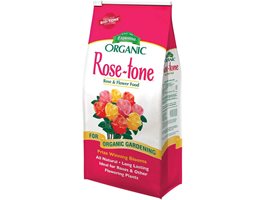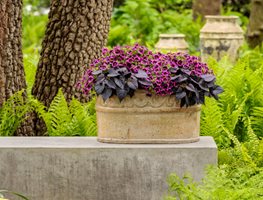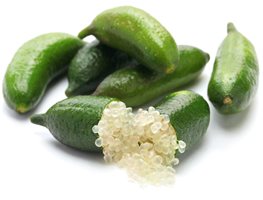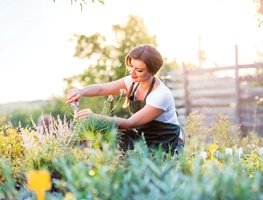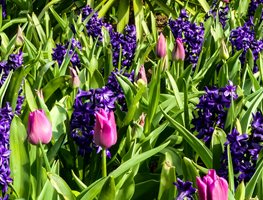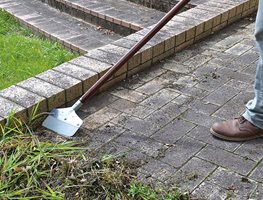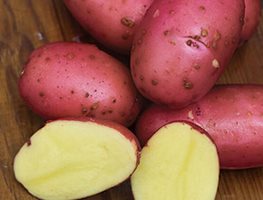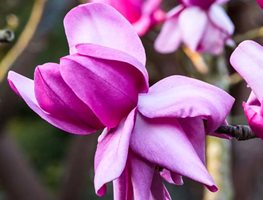10 Gardening Activities for March in the Northern California
Here are a few garden reminders, tips, inspiring ideas, and maintenance suggestions for your garden this month.
1. Start Feeding Roses
In March, roses typically begin their growing season with stem growth and foliage returning. Feed your roses with a rose fertilizer such as Rose-tone or Dr. Earth Total Advantage Rose & Flower Fertilizer, and follow a regular monthly feeding schedule throughout the growing season. Caring for roses organically starts with proper soil, but you also need to create an ecosystem within your rose garden that attracts beneficial insects that will eat aphids and other pests. You should also make sure your roses get good air circulation and light. Read this informative article on growing roses organically from the rose expert at The Scott Arboretum.
2. Add Annuals to Hanging Baskets, Containers & Window Boxes
One of the easiest ways to add early color to your garden is by planting annuals in hanging baskets, containers, and window boxes. Begin by planting cool-season annuals that will bloom earlier such as calendula, lobelia, larkspur, petunia, oriental poppies, daisies, and viola. Include later-blooming annuals such as snapdragons, hollyhock, delphiniums, nicotiana, geranium, and nasturtium in your planting combinations for a succession of blooms. Plants can be found at local garden centers where annuals should be on display, as well as online through retailers such as Proven Winners and Annie's Annuals & Perennials (based in Richmond, California).
3. Continue Planting Spring-Planted Bulbs, Corms & Tubers
Get your bulbs in the ground throughout March. From anemones to dahlias, gladiolus to ranunculus, spring-planted bulbs can still be planted this month. When planting most bulbs, corms, and tubers, dig a hole 2 to 3 times as deep as the bulb height. For dahlias, dig a hole roughly 6 inches deep. Though bulbs can survive in very lean (nutrient-deprived soil) they flower best in well-draining, nutrient-rich soil. When planting, mix in compost and bulb fertilizer such as Bulb-tone and water well. You can typically wait to do supplemental watering until foliage emerges and flower buds start developing. Rainfall will usually provide enough moisture before foliage emerges. If the weather is unusually dry, give bulbs a deep watering once a week. Find spring-planted bulbs online at American Meadows, Brent and Becky's Bulbs, or Longfield Gardens.
4. Plant Citrus Trees
March is a good month to plant citrus in Northern California; the weather is still cool and the often wetter conditions help tree roots establish quickly. When planting citrus, be sure to select a location with full sun (at least 6 hours of direct sunlight, but preferably more) and well-draining, nutrient-rich soil. You’ll want to avoid highly compacted soil, heavy clay, and areas that stay wet. For backyards, it’s often best to select semi-dwarf trees that don’t get too large. Smaller trees mean you can fit more varieties into your garden and the fruit is easier to pick. Look for trees at Four Winds Growers (based in Half Moon Bay, California) that sell a wide range of semi-dwarf citrus and other fruit trees online. Be sure to check out their offbeat varieties too: Buddha's Hand Citron, Australian Finger Lime (pictured), Moro Blood Orange.
5. Cut Back Perennials
If you haven’t already, cut back perennials and ornamental grasses. New growth will emerge soon, so your garden won’t look bare for long. Fertilize your plants to help rejuvenate them with a slow-release fertilizer and a generous layer of compost. If your soil is compact, loosen it around perennials and grasses with a broad fork or shovel. This will open up channels in the soil so air, water, and roots can penetrate it more easily.
Don't miss what to do in the garden each month, make sure you're getting our weekly newsletter.
6. Leave Foliage on Spring-Blooming Bulbs
After the blooms on spring-blooming bulbs fade, leave foliage intact while it’s still green. The foliage will restore nutrients to the bulbs, corms, and tubers that will be used to produce next year’s flowers. You can continue fertilizing and watering bulbs while foliage is green. This is the bulb’s active time to replenish nutrients. Once the foliage has died back and turned yellow, it can be cut it off.
7. Weed Early & Often
Catching weeds before they develop seeds is an important step in weed management. Be sure to weed frequently in small doses when weeds are young. If left to mature, many develop strong roots as well as seeds that will spread around your garden. Weed early in the morning while soil is moist and roots are easier to remove. Read more about how to get rid of weeds, and try these tools that can make it a little easier on your hands, knees, and back:
8. Refresh Raised Beds with Compost & Fertilizer
If you haven’t refreshed your raised beds with compost and fertilizer, do so now. You may have already planted cool-season crops, so wait until you turn beds over to warm-season crops to add large amounts of compost. When applying compost, add 3 to 4 inches to garden beds. If your soil is compacted, dig in or mix in the compost. Sprinkle an all-purpose produce fertilizer over the beds and mix it into the soil.
9. Plant Potatoes
Potato plants can produce large amounts of food when cared for properly. (Get a quick overview on planting and caring for potatoes.) If you’re looking for interesting potato varieties, check out Burpee or Seed Savers Exchange where you can find everything from the standard Yukon Gold to purple Magic Molly or the tie-dyed Masquerade.
10. Visit the San Francisco Botanical Garden
The San Francisco Botanical Garden is filled with blooms in the spring from February through April. The show starts with their large collection of magnolias. The magnolia collection includes more than 200 trees, representing 63 species and 49 cultivars. If you visit in late February or early March you may still be able to catch some of the blooms. There are many other spring flowers blooming through March as well—from rhododendrons to California natives, there’s a lot that looks good this time of year.
See more about the San Francisco Botanical Garden and other nearby gardens in our Self-Guided Day trip for San Francisco.
If you enjoyed this information, sign up for our weekly newsletter. Each week, you'll get Garden Design's best delivered right to your inbox including design tips, plant picks, great gardens, outdoor living products, and events to enjoy — along with monthly gardening checklists just for your area.
Do you know someone who would enjoy this Northern California Region gardening information? Why not share it with them?
When you purchase products through links on our site, we may receive an affiliate commission. Thank you for your support.
